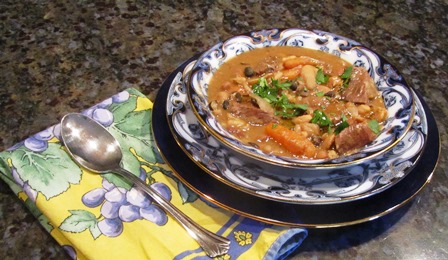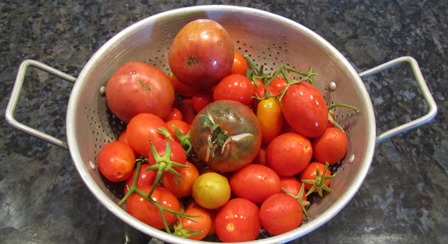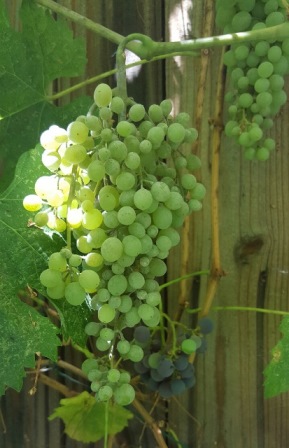What’s Growing in the July Garden?

Sunflowers are native to North America and were taken to Europe in the 16th century; however, they date back to roughly 3,000 B.C. Honeybees love sunflowers.
Towering above the squash and lavender in my garden are rows of green corn stalks bearing ears of sweet, plump kernels. Snaking along the rows at the base of the cornstalks are vines laden with butternut squash and Armenian cucumber.
There are ripe tomatoes, too, especially the prolific heirloom–Red Beefsteak. I love cutting up some of these fresh, thin-skin tomatoes and combining them with basil, olive oil, grated cheese, and pine nuts as a topping for pasta. Add some grilled, seasoned chicken and you’ve got a quick and delicious summer lunch.
Zucchini and yellow squash sport large, showy blooms and are producing like crazy this month. While you can harvest and eat the blooms, we prefer the squash. Zucchini is delicious grilled or tossed with rosemary potatoes and onions or made into a French lentil and tomato salad (see recipe from last week’s posting).
Growing on vines trained over a wall and on supports, the green table grapes are beginning to swell. The taste is still a little tart, but will sweeten with the passage of another couple of weeks.
* * *
If you enjoy reading about farmette topics (including gardening, beekeeping, and delicious recipes), check out my cozy mysteries A BEELINE TO MURDER and also THE MURDER OF A QUEEN BEE in the Henny Penny Farmette series (from Kensington Publishing).
These novels are available through online retailers such as Amazon, Barnes & Noble, Kobo Books, and Walmart as well as from traditional bookstores everywhere.
Now available in mass market paperback, this debut novel launched the Henny Penny Farmette series of mysteries and sold out its first press run.
COMING SOON: The second cozy mystery in the Henny Penny Farmette series, available Sept. 29, 2016
Home-cooked Meals Made Easy for Harried Holiday Shoppers
Family and friends may love the hustle and bustle of holiday activities but often are too tired at the end of the day to cook. There’s a simple solution. Before leaving the house, someone needs to assemble a stew or meal that simmers all day in a slow cooker.

A hearty bean and beef stew is garnished with a dash of extra virgin olive oil, Italian parsley, and coarsely ground black pepper
The process is simple. Choose your meal, put the ingredients in a slow cooker, turn it on, and forget about it until you are ready to feed your gang at the end of the day.
Slow cookers are terrific tools for making tasty stews like apple chicken, Mexican pork and hominy, and red beans with Cajun sausages. Or, make a corned beef and cabbage dish with carrots and potatoes. Beef stroganoff, pepper steak, and even clam chowder or a fish stew taste sublime when cooked slowly for several hours.
Serve your hot meal alongside a simple salad. Choose perhaps broccoli slaw with chopped apples and pears, segments of seedless tangerines, and a handful of sliced almonds. Drizzle or spritz with Asian Sesame Ginger dressing. Put out slices of French bread and possibly a platter of cheese.
Right before serving the meal, sprinkle the hot food with some fresh herbs, a dash of olive oil, some shaved cheese, or coarsely ground black pepper. What could be easier?
For more delicious farmhouse recipes, tips for keeping honeybees and chickens, growing heirloom vegetables, and tending fruit trees, check out my latest book, A BEELINE TO MURDER.
Released in hardcover, the book makes a great gift for holidays, birthdays, and other celebratory events. Available online and a brick-and-mortar bookstores everywhere. See, http://tinyurl.com/p8d6owd

The first cozy mystery in the Henny Penny Farmette mystery series by Meera Lester, from Kensington Books
Choosing the Milk for the Cheese …Goat or Cow?
Imagine the taste on your palate of warm figs with a dollop of goat cheese right off the grill, accompanied by a lovely California red wine. Now re-imagine that cheese produced by your own goat. This is my new dream.
For me, the taste of cheese and yogurt produced from goat’s milk is preferable to the taste of the same products made from cow’s milk. Lately, I’ve been considering the pros and cons of owning a goat versus a cow.
My list goes something like this:
Goat:
Smaller (easier to transport, shelter, and handle)
Eats less feed, therefore costs less to keep
Produces less milk (which is an advantage when your family is small and doesn’t drink much milk)
Goat manure is dry (arrives on the ground in pellet form)
Goats are great foragers and keep weeds and grasses nibbled away
Cow:
Bigger (needs larger shelter and transportation)
Eats more, drinks more, therefore costs more to keep
Produces more milk than goats
Cow manure is wet (turns into dry “pies”)
Cows need pasture and feed (cows eat roughly ten times as much as a goat)
I’m thinking I’d need a farm to own a cow; but for my little farmette, a goat makes more sense. As for choosing the type of goat; well, that’s another process. For now, I think I’ll pick some summer figs and melt a little goat cheese on top. Wine anyone?
 Facebook
Facebook Goodreads
Goodreads LinkedIn
LinkedIn Meera Lester
Meera Lester Twitter
Twitter








